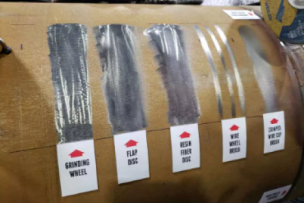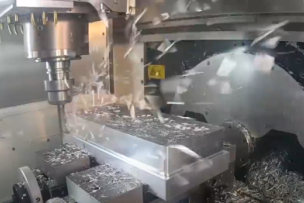“Wetting” is the term that metalworking fluid (MWF) industries use to describe the ability of a fluid to spread out, penetrate, and cover the tool, the work piece, the chips, and the machine. This ability to over or wet surfaces is critical to fluid performance. These wetting characteristics have two components: how well the fluid spreads (static surface tension) and how rapidly the spreading occurs (dynamic surface tension). On a theoretical level, wetting is a function of fluid surface tension that can be defined as the tangential force that keeps a fluid together at the gas/fluid interface, or if you prefer “surface tension is the intermolecular force of attraction between adjacent molecules, expressed in force per unit width (dynes/centimeter or miliNewtons/meter).” It is impossible to measure these forces directly, but they can be calculated using a variety of methods.
The difference in molecular structure causes the molecules in water to be attracted to one another. With an imbalance of forces at the surface of the water, the molecules pull closer at the surface, creating a very thin “elastic skin” on the water’s surface. This is called surface tension. (Without surface tension, ducks would not float because their feathers would become too saturated.)
These methods involve creating a standard volume drop of fluid then measuring the shape, the angle at which it contacts another surface, or rate it changes when it contacts another surface (and there are others). Each method has advantages and disadvantages, but they all attempt to measure how well the fluid “wets” in a specific situation. It is important to understand that where metalworking fluids are used there are many environmental issues that can affect a fluid’s wetting ability.
These include:
- Hard water – The cations (primarily magnesium Mg++ and calcium Ca++) react with surfactants formulated into the fluid that tend to reduce its ability to wet.
- Metals in solution – Cations that come from other metals in solution will react with the surfactants. If the reaction occurs with multi-valiant ions the surfactants are removed from the solution. If they react with mono-valiant ions, different types of surfactants are formed which may or may not change the surface tension.
- Tramp oil – When tramp oil gets into solution it tends to use up surfactants as they try to emulsify the oil. In situations where the tramp oil contains surfactants (is a “high detergent” oil), the surfactant balance may be upset as well.
Generally, the better a MWF wets (spreads rapidly and evenly), the better the fluid works – whether it is a coolant, straight cutting oil, forming fluid, or a parts washing compound. However, very low surface tensions nearly always result in increased foam and mist. A fluid’s wetting or surface tension affects many aspects of the metalworking process, some of which are:
- Foam – In general fluids with lower surface tension foam more than those with higher surface tension; however, the selection of a particular surfactant has a great deal to do with stability of the foam. In general, smaller bubbles are more stable than larger bubbles.
- Machine and part cleanliness – The ability of a fluid to wet the surface then “sheet off” is critical to keeping the machine, parts, and chips clean.
- Fluid usage – This depends on the type of metal. Nonporous metals like steel and aluminum wet and sheet off more readily to provide good rust protection with less carryoff and less fluid usage. Rough, porous materials like gray iron and many sintered metals have a very high surface area. So, when all surfaces are wetted, higher carryoff results.
- Corrosion – For a fluid to provide a corrosion preventative film, it is critical that all surfaces of the material be wetted with the corrosion inhibitor.
- Tramp oil rejection – MWF with lower surface tension tends to have “available” surfactants in the system. These surfactants emulsify tramp oil that gets into the fluid. Lighter oils like spindle, hydraulic, and automatic transmission fluids (ATF) are more easily emulsified than gear and way oils.
- Hard water tolerance – Highly surface-active fluids (those with lots of wetting agents) are not as tolerant to hard water as those with fewer surfactants. Hard water minerals react with surfactants to form hard water soaps.
- Filtration – With the reduction in surface tension, chips settle faster (its settling rate increases) and flows (flux rate) through media more readily (its rate of filtration increases).
- Tool life – For a fluid to work effectively it must reach the tool work piece interface. Fluid with lower static and dynamic surface tension does this better than those with higher surface tension.
- Wheel life and surface finish – Because grinding wheels typically run much faster than “big chip tools,” the ability of fluid to rapidly wet the grinding wheel is critical to its success.
Wetting, like so many other MWF characteristics, is a very complex issue and an answer to the question “How well does this fluid wet?” only provides part of the information necessary to make an informed fluid selection, or to troubleshoot a fluid problem.
Surface Tension of Some Typical Fluids
Water: 72 dynes/cm
Typical Soluble Oil: 30-50 dynes/cm
Typical Surface Active Fluid: 20-30 dynes/cm
Typical True Solution Fluid: 40-60 dynes/cm
Typical Semisynthetic Fluid: 25-35 dynes/cm
“Good” Wetting Threshold: less than 30 dynes/cm
- Wetting is a function of fluid surface tension that can be defined as the tangential force that keeps a fluid together at the gas/fluid interface.
- The better a metalworking fluid wets (spreads rapidly and evenly), the better the fluid works.
- A fluid’s wetting or surface tension affects many aspects of the metalworking process.
Previously featured on MasterChemical.com




Talk to Us!
I am new to serious coolant use in manufacturing.
I am machining Aluminum and using high pressure coolant.
What I need is a detailed list of things to check, how often to check, how to check and what to do to adjust and maintain the fluids.
What do you have?
Al
33I didn't realize how important it is to find a metalworking fluid that spreads and quickly and evenly. This will make it easier to finish my company's project efficiently. Also, it makes sense that I should also consider the surface tensions of different fluids and oils to make sure they are safe to use in metalworking. https://lampcoindustries.com/metalworking-fluids/
29I didn't know that foam could be used in metal forming. I need a metal sword made for my brother. He is really into medieval culture and wants a replica. http://cvc-fab.com/
44Leave a reply
Your email address will not be published. Required fields are marked *